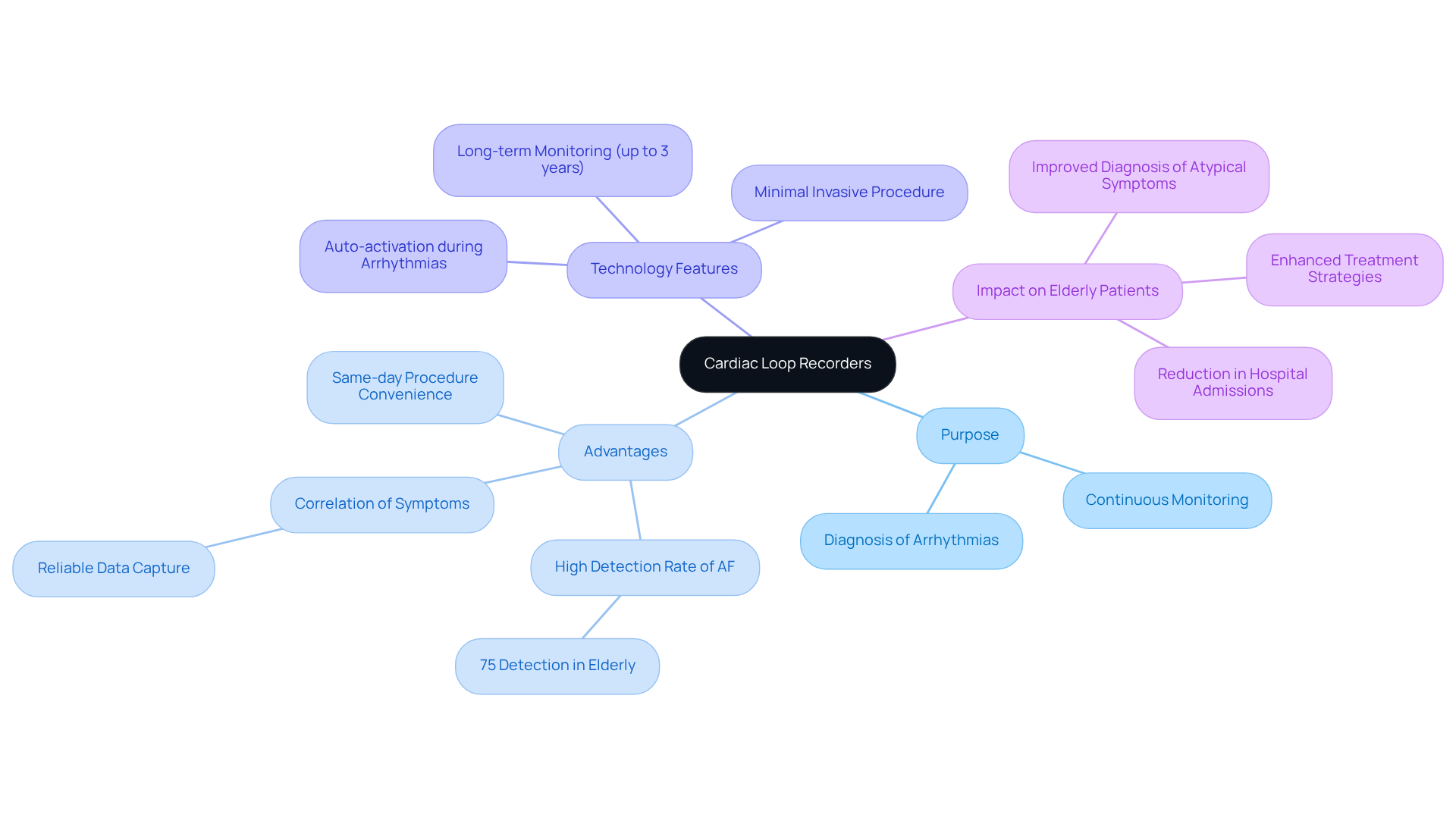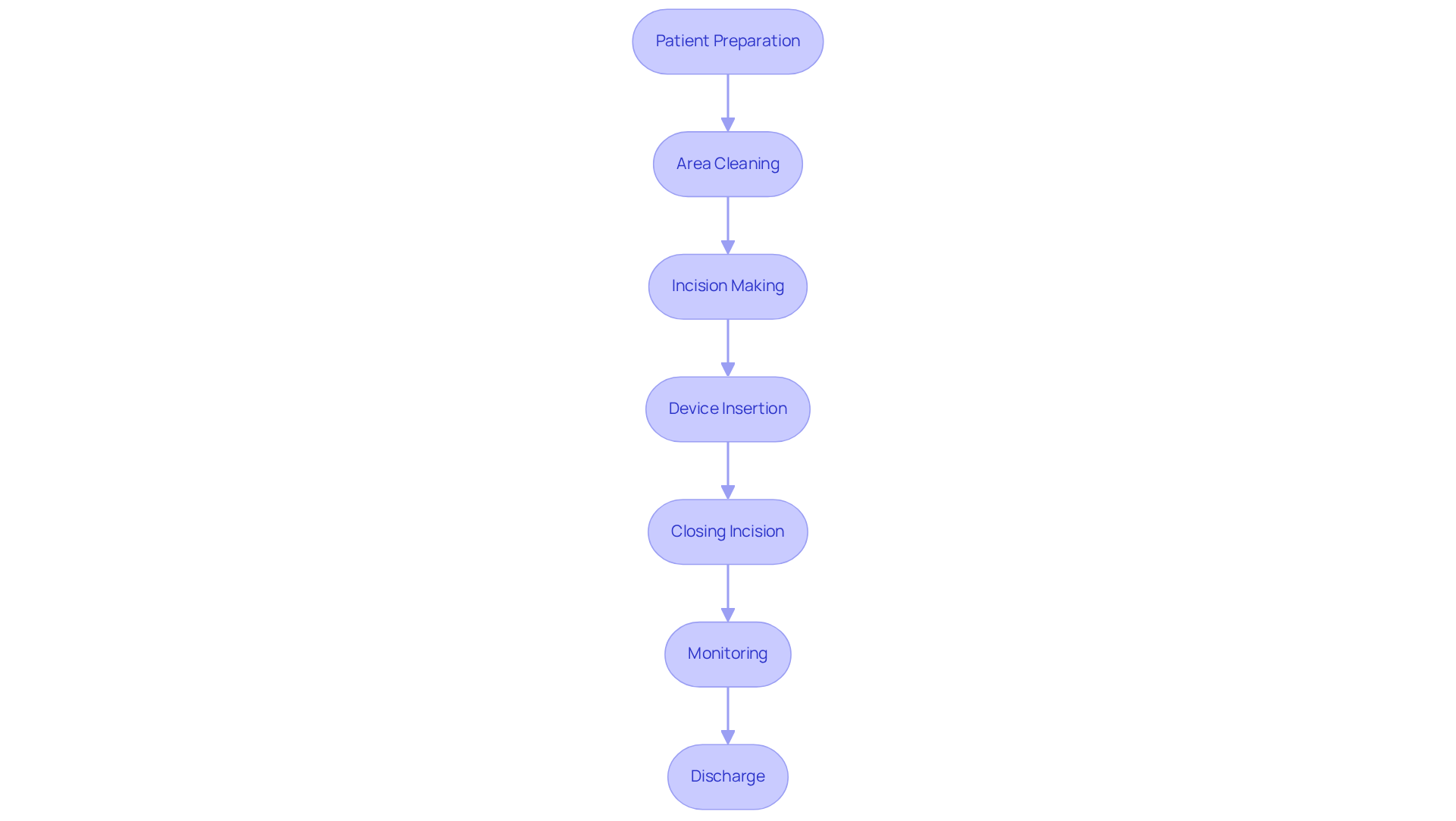


Cardiac loop recorders, also known as ILRs, play a vital role in continuously monitoring the heart's electrical activity. This is especially important for diagnosing arrhythmias in older adults, who may experience symptoms that are not typical. It's reassuring to know that ILRs can effectively identify conditions like atrial fibrillation in 75% of elderly patients. This capability not only enhances treatment strategies but also significantly improves health outcomes through timely intervention.
If you or a loved one are experiencing unusual heart symptoms, it's essential to consider the benefits of ILRs. They provide a compassionate approach to understanding your heart health, ensuring that you receive the care you deserve. Remember, seeking help is a strong step towards better health and peace of mind.
Cardiac loop recorders, or implantable loop recorders (ILRs), represent a significant advancement in the ongoing battle against arrhythmias, particularly among the elderly. These small devices, implanted beneath the skin, provide continuous monitoring of heart activity for up to three years. This invaluable data can lead to timely diagnoses and personalized treatment plans, offering hope and support to those affected.
However, as with any medical procedure, it is natural to have concerns. Understanding the potential risks and the implantation process itself raises essential questions:
By addressing these questions, we aim to provide clarity and reassurance. It’s important to feel informed and supported every step of the way, allowing you to make the best decisions for your health. Remember, you are not alone in this journey; there are resources and professionals ready to assist you.
Cardiac loop recorders, also known as implantable loop recorders (ILRs), are small devices that are surgically inserted beneath the skin of the chest. The cardiac loop recorder is designed to continuously monitor and record the heart's electrical activity for up to three years. This prolonged monitoring using a cardiac loop recorder is crucial for diagnosing arrhythmias—irregular heartbeats that can pose serious health risks. For our elderly patients, where symptoms may often be atypical, the cardiac loop recorder captures critical data during episodes of abnormal heart rhythms, providing healthcare professionals with essential insights that inform treatment strategies.
At Amavita Heart and Vascular Health, we understand the prevalence of arrhythmias in older adults. Studies indicate that atrial fibrillation (AF) is particularly common in this demographic. In fact, research shows that AF was identified in 75% of older individuals who underwent implantation of a cardiac loop recorder for suspected AF. This high detection rate underscores the in identifying heart rhythm disorders that might otherwise go unnoticed.
Our cardiologists emphasize the advantages of the cardiac loop recorder (ILR), noting that it offers a reliable means of correlating symptoms with documented heart rhythm abnormalities. One expert mentioned that the use of a cardiac loop recorder can provide a more reliable connection between an individual's symptoms and their heart's electrical activity. This is particularly advantageous for those facing recurrent syncope or unexplained palpitations.
Furthermore, recent advancements in cardiac loop recorder technology have further enhanced their utility. Modern devices come with features that enable automatic activation during arrhythmias, ensuring that critical data is recorded even when individuals are unaware of their symptoms. This capability is especially beneficial for older individuals, who may not always identify or communicate their symptoms correctly when monitored by a cardiac loop recorder.
At Amavita, we also prioritize same-day convenience for our clients. We allow them to undergo procedures and return home on the same day, minimizing disruption to their lives. Overall, the introduction of cardiac loop recorders as implantable monitoring devices signifies a considerable improvement in cardiac care for older adults. They provide a secure and efficient approach for long-term arrhythmia observation with a cardiac loop recorder. By facilitating timely diagnoses and personalized treatment plans, ILRs play a vital role in improving heart health outcomes in this vulnerable population.

Cardiac loop recorders are essential tools for understanding unexplained syncope (fainting) and palpitations, especially in individuals experiencing infrequent or unpredictable symptoms. Unlike traditional monitoring methods such as Holter devices, the cardiac loop recorder provides ongoing data, making it particularly effective in identifying (AF). This common arrhythmia, especially prevalent in older adults, significantly heightens the risk of stroke. In fact, recent research reveals that AF is detected in around 75% of elderly individuals who receive a monitoring device for suspected AF. This capability empowers healthcare providers to make well-informed decisions about treatment options, which may include necessary medication adjustments or further interventions.
The diagnostic yield of the cardiac loop recorder is notably high, with studies showing that it can lead to clinically important changes in management for almost half of the individuals observed. By facilitating early identification and intervention, these devices not only enhance health outcomes but also support more effective management of cardiovascular health in the elderly. Remember, you are not alone in this journey; there are solutions available that can help you feel more secure and supported in your health care.

The implantation of a cardiac loop recorder is a minimally invasive outpatient procedure, typically performed under local anesthesia. This reflects Amavita's commitment to innovative cardiovascular care, aimed at putting patients at ease. The process begins with you comfortably positioned on an examination table, where your healthcare provider will first clean the area on your chest where the device will be inserted. A small incision, usually about 1-2 centimeters, is made just below the left collarbone, allowing the loop recorder to be placed subcutaneously. This process typically takes around 13 to 14 minutes to complete.
Once the device is securely in place, the incision is closed with stitches or adhesive strips. You will then be monitored for a brief period to ensure there are no immediate complications. Most individuals can return home the same day and often resume normal activities within 24 to 48 hours after the procedure. Complete healing of the incision site usually occurs within one week. This is a hallmark of Amavita's approach to heart care, designed with your comfort in mind.
Real-world examples illustrate the efficiency of this technique. Studies indicate that only 2 complications arose in 204 operations, highlighting the safety of the implantation process. Research shows extremely low complication rates overall, reinforcing the safety profile of the operation. Surgeons emphasize the importance of educating individuals about activating the device during symptomatic episodes, as up to 23% may fail to activate it correctly. This activation is essential for maximizing the diagnostic yield. Furthermore, arranging transportation home after the procedure can help ensure a smooth recovery process.
Overall, the outpatient aspect of the cardiac loop recorder implantation allows for a swift recovery, making it a preferred choice for those requiring long-term cardiac observation. Your health and well-being are our top priorities, and we are here to support you every step of the way.

While cardiac loop recorders (ILRs) are generally safe, we understand that can be a source of concern. Common issues may include:
In fact, infection rates are reported as low as 0.1% in a large observational study involving 1,900 individuals. However, we acknowledge that the migration of the device from its original position is a rare but significant concern, potentially requiring surgical intervention, such as video-assisted thoracoscopic surgery (VATS). It’s important for patients to monitor the insertion site closely for any signs of infection, such as:
Patients should promptly report any unusual symptoms to their healthcare provider. Prophylactic antibiotics may be administered prior to the procedure to enhance safety for individuals.
Regular follow-up appointments are crucial for ensuring the proper functioning of the cardiac loop recorder and for addressing any concerns that may arise during the monitoring period. These checkups typically occur once or twice a year while the loop recorder is in place. At Amavita, our Optimal Program features:
These are particularly important for older individuals who may have additional comorbidities that could complicate recovery. Our cardiologists emphasize the importance of optimizing implantation techniques for the cardiac loop recorder and employing effective follow-up strategies to mitigate risks.
Real-world examples show that many individuals can return to their normal activities shortly after the procedure. However, it’s essential to remain vigilant for any signs of complications. Overall, understanding these risks and maintaining open communication with healthcare providers can significantly enhance patient safety and outcomes during the monitoring process. This is especially true when supported by comprehensive programs like those offered at Amavita, where we genuinely care about your health and well-being.

Cardiac loop recorders mark a remarkable step forward in the continuous monitoring of heart health, especially for older adults who may be at risk of arrhythmias. These devices provide long-term data on heart rhythms, allowing healthcare professionals to identify conditions that might otherwise remain hidden. This capability leads to timely and effective treatment strategies, ensuring that patients receive the care they need.
In this article, we've explored the various aspects of cardiac loop recorders, from their essential role in diagnosing arrhythmias to the minimally invasive implantation procedure and the potential complications that may arise. The high diagnostic yield, combined with the ability to correlate symptoms with recorded heart activity, highlights their significance in managing cardiovascular health, particularly within the elderly community.
Ultimately, integrating cardiac loop recorders into patient care not only enhances our understanding of heart conditions but also empowers individuals to take charge of their health. By facilitating early detection and personalized treatment plans, these devices play a vital role in improving health outcomes. If you are considering a cardiac loop recorder, we encourage you to engage in open discussions with your healthcare provider about the procedure and its benefits. Such conversations can lead to a more informed and proactive approach to your heart health, ensuring that you feel supported every step of the way.
What are cardiac loop recorders?
Cardiac loop recorders, also known as implantable loop recorders (ILRs), are small devices surgically inserted beneath the skin of the chest to continuously monitor and record the heart's electrical activity for up to three years.
What is the purpose of a cardiac loop recorder?
The primary purpose of a cardiac loop recorder is to diagnose arrhythmias, which are irregular heartbeats that can pose serious health risks. They capture critical data during episodes of abnormal heart rhythms, especially in elderly patients where symptoms may be atypical.
How effective are cardiac loop recorders in detecting arrhythmias in older adults?
Cardiac loop recorders have shown a high detection rate for atrial fibrillation (AF) in older adults, with research indicating that AF was identified in 75% of individuals who underwent implantation for suspected AF.
What advantages do cardiac loop recorders offer?
Cardiac loop recorders provide a reliable means of correlating symptoms with documented heart rhythm abnormalities, offering insights particularly beneficial for individuals experiencing recurrent syncope or unexplained palpitations.
What advancements have been made in cardiac loop recorder technology?
Recent advancements include features that enable automatic activation during arrhythmias, ensuring critical data is recorded even when individuals are unaware of their symptoms, which is especially helpful for older adults who may struggle to identify or communicate their symptoms.
What is the procedure for receiving a cardiac loop recorder at Amavita Heart and Vascular Health?
Amavita offers same-day procedures for cardiac loop recorder implantation, allowing clients to undergo the procedure and return home on the same day, minimizing disruption to their lives.
How do cardiac loop recorders improve heart health outcomes for older adults?
By facilitating timely diagnoses and personalized treatment plans, cardiac loop recorders play a vital role in improving heart health outcomes in older adults, providing a secure and efficient approach for long-term arrhythmia observation.